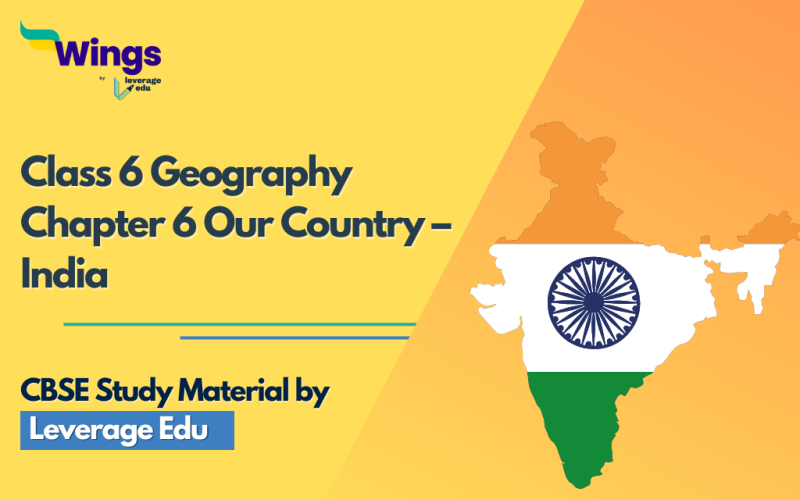Summary: NCERT Class 6 Geography Chapter 6
NCERT Class 6 Geography Chapter 6, titled “Our Country India,” explores the diverse features of India. It begins by highlighting India’s vastness and its unique shape. The chapter delves into the various physical features, such as mountains, plateaus, plains, and rivers, which shape the landscape. The Himalayas, the highest mountain range, are discussed along with their significance. The fertile plains, like the Indo-Gangetic plain, are essential for agriculture. The plateau region, with its rich minerals, is explained.
Also, the chapter introduces the major rivers like the Ganga and the Brahmaputra, crucial for irrigation and transportation. It also touches upon the different climate zones in India, from hot deserts to coastal regions. The chapter concludes with a brief overview of India’s neighbouring countries.
Download Social Science Class 6 Geography Chapter 6 Important Questions and Answers PDF
Table of Contents
Explore all the Chapters of Class 6 Geography:-
Also Read: Which Region Receives the Most Rainfall in India?
Important Definitions in NCERT Class 6 Geography Chapter 6
- Peninsula: The peninsula is a piece of land that is surrounded by water on three sides.
- Alluvial deposits: These are very fine soils, brought by rivers and deposited in the river
- basins.
- Tributary: A river or stream which contributes its water to a main river by discharging it into the main river from either side.
Also Read: Which is the Longest River in India?
Download Social Science Class 6 Geography Chapter 6 Important Questions and Answers PDF
Explore all the Chapters of Class 6 Geography:-
Important Questions and Answers in NCERT Class 6 Geography Chapter 6
1. Answer the following questions briefly.
(a) Name the major physical divisions of India.
(b) India shares its land boundaries with seven countries. Name them.
(c) Which two major rivers fall into the Arabian Sea?
(d) Name the delta formed by the Ganga and the Brahmaputra.
(e) How many States and Union Territories are there in India? Which states have a common capital?
(f) Why do a large number of people live in the Northern plains?
(g) Why is Lakshadweep known as a coral island?
Ans.
(a) The major physical divisions of India are the Himalayan Mountains, Northern Plains, Peninsular Plateau, Thar Desert, Coastal Plains, and Islands.
(b) India shares its land boundaries with seven countries: Pakistan, China, Nepal, Bhutan, Bangladesh, Myanmar, and Afghanistan.
(c) The two major rivers that fall into the Arabian Sea are the Indus and the Narmada.
(d) The delta formed by the Ganga and the Brahmaputra is called the Sundarbans Delta.
(e) India has 28 States and 8 Union Territories. The states of Haryana and Punjab have a common capital, which is Chandigarh.
(f) A large number of people live in the Northern plains because the soil there is very fertile due to the deposition of silt by rivers like the Ganga and the Yamuna. This makes it suitable for agriculture, and hence, many people settle there.
(g) Lakshadweep is known as a coral island because it is made up of coral reefs. These reefs provide a unique and diverse ecosystem for marine life, making it an important area for biodiversity.
2. Tick the correct answers.
(a) The southernmost Himalayas are known as
(i) Shiwaliks (ii) Himadri (iii) Himachal
(b) Sahyadris is also known as
(i) Aravali (ii) Western Ghats (iii) Himadri
(c) The Palk Strait lies between the countries
(i) Sri Lanka and Maldives
(ii) India and Sri Lanka
(iii) India and Maldives
(d) The Indian islands in the Arabian Sea are known as
(i) Andaman and Nicobar Islands
(ii) Lakshadweep Islands
(iii) Maldives
(e) The oldest mountain range in India is the
(i) Aravali hills (ii) Western ghats (iii) Himalayas
Ans:
a- (i) Shiwaliks
b- (ii) Western Ghats
c- (ii) India and Sri Lanka
d- (ii) Lakshadweep Islands
e- (i) Aravali hills
3. Fill in the blanks.
(a) India has an area of about 3.28 million sq. km.
(b) The Greater Himalayas are also known as Himadri.
(c) The river Narmada falls into the Arabian Sea.
(d) The latitude that runs almost halfway through India is the Tropic of Cancer.
4. On an outline map of India, mark the following.
(a) Tropic of Cancer
(b) Standard Meridian of India
(c) State in which you live
(d) Andaman Islands and Lakshadweep Islands
(e) Western Ghats and Eastern Ghats
Ans:
Also Read:
NCERT Class 6 Geography: Chapter-1 The Earth in the Solar System
NCERT Class 6 Geography: Chapter- 2 Latitudes and Longitudes
NCERT Class 6 Geography: Chapter-3 Motions of the Earth
NCERT Class 6 Geography: Chapter-4 Maps
NCERT Class 6 Geography: Chapter- 5 Major Domains of the Earth
Explore Notes of All subjects of CBSE Class 6:-
| CBSE NCERT Notes Class 6 English | CBSE NCERT Notes Class 6 History | CBSE NCERT Notes Class 6 Geography |
| CBSE NCERTNotes Class 6 Civics | CBSE NCERT Notes Class 6 Mathematics | CBSE Notes of Class 6 Science |
FAQs
What is a Peninsula?
The peninsula is a piece of land that is surrounded by water on three sides.
What is an Alluvial deposit?
These are very fine soils, brought by rivers and deposited in the river
Basins.
What is a Tributary?
A river or stream contributes its water to a main river by discharging it into the main river from either side.
Follow Leverage Edu for complete study material on CBSE Notes of Class 6 Geography
 One app for all your study abroad needs
One app for all your study abroad needs













